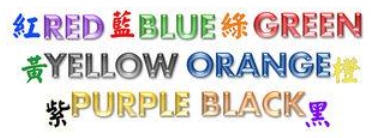Social Conditioning
We are sure you will agree that we all inherit or assimilate certain biased attitudes and values from our parents, schools, friends, and so on. Many of these attitudes and values come to us before we are able to test them for their validity. Later on in life, some of these attitudes and values seem to be obviously true

and we do not think about whether we need to question them. Simply by the accident of birth, we find ourselves in a particular place at a particular time in history. The customs, social institutions and material setting of that place and time decisively influence the way we see the world. This background frames our view so much that it is only with difficulty that we can turn around and critically assess the framework itself.
Here is an interesting activity illustrating that we are conditioned to see only what we want to see. Access your own preconceived ideas by doing the activity. Read aloud the colors, and not the words, you see in the list below.

Think about it: Did you read the correct colors or were you influenced by the visual colors of the words? This activity clearly illustrates our social conditioning.
Preconceived ideas are embedded in, and borrow their “obviousness” from, our social conditioning framework. The ideal of critical thinking is to step outside this framework and make judgments in the manner of an ideal observer. While the standard of absolute objectivity may be regarded as a regulative ideal, it would be naïve to think that this can be achieved, especially when it comes to issues such as morality, justice and aesthetics. But skepticism about the possibility of absolute objectivity need not deflect us from attempting to achieve some distance from our social backgrounds and the preconceived ideas we grew up with. Social conditioning is an obstacle to critical reasoning, but it is not an insurmountable obstacle.
As we learn the names for different things and how to go about operating as human beings in society, we are told what is good and what is bad, what is to be desired and what is to be avoided, and what it means to be in the world in general. Most of this is perfectly innocent and practical, but our parents’ or guardians’ various judgments of themselves and of the world will creep in whether we are aware of it or not. In simplified terms, some people have a positive outlook on life while others have a negative outlook, and whether our parents believe they live in a world that is threatening and negative, or one that is helpful and positive, will have a deep impact on our psyche.
If our parents live in the illusion that money is important, politicians are corrupt, marriage is nothing special, and work is tedious, then that becomes part of our own outlook as well. Some of these negative beliefs are so deeply ingrained in our society that we don’t even notice them, and they then become stuck in our subconscious while our context and perspective are still relatively limited.
Consider the following claims (or opinions) about two people from different backgrounds and then answer the questions that follow:
- Peter grew up in the wealthy northern suburbs of New York City. Therefore, Peter is likely to believe in the values of individuality and the superiority of capitalism.
- Paul grew up in a poor suburb of Detroit, MI. Therefore, Paul is likely to believe in the value of community and the superiority of socialism.
- Do you think that these claims are based on sound reasoning? Why? Why not?
- Would you say that these claims are based on preconceived ideas? Why? Why not?
- What preconceived ideas are embedded in these arguments?
Think about it: These claims are not outcomes of reflective critical reasoning. Rather, they are assumptions based on preconceived ideas about socioeconomic class and personal identity and values.
